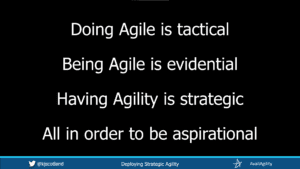Last week Jose Casal posted on LinkedIn about how Agile and Agility are not the same thing. In that post, he includes a photograph of an old slide of mine with the words “Agility is a Strategy. Agile is a Tactic”. It created a fair amount of reaction so I thought it would be worth expanding on that and describing what I mean by Strategic Agility.
The slide was from a presentation “Turn Your Organisation Into A Laboratory with Strategy Deployment” from Lean Kanban Central Europe in 2015. I originally blogged about Agility is a Strategy, Agile is a Tactic the same year. Additionally, there is another related post which talks about Agility as a strategy. This is about Good Agile/Bad Agile and describes Agile in terms of Richard Rumelt’s Strategy Kernel i.e. Diagnosis, Guiding Policies and Coherent Action.
Chatting with Jose privately he reminded me of a talk from Jean Tabaka called “Tell Me Why: The Golden Circle of Agile Transformation”. We managed to find the slides from when she gave it at GOTO 2011. For me, that shows that these ideas have been around for a long time. Jean was certainly an inspiration for my interest in Strategy Deployment and Strategic Agility. (I miss Jean).
All this also reminded me that I have also used a fuller version of that slide. I found a version (above) in a workshop on Deploying Strategic Agility. I think expresses my intent more clearly.
- Doing Agile is Tactical.
- Being Agile is Evidential.
- Having Agility is Strategic.
- All in order to be Aspirational.
Let’s unpack that from the bottom up (or Left to Right as Mike Burrows would say).
All in order to be Aspirational
At the end of the day, organisations want to be successful, and they have aspirations for how that success might be realised. In terms of the Golden Circle model reference by Jean, it’s their Why. At this point, Agile is not directly relevant. It’s not the end goal.
Having Agility is Strategic
To achieve those aspirations, organisations often need to change or transform. In terms of Rumelt’s Strategy Kernel, they have a Diagnosis of a problem. Agility can be used as a basis for Guiding Policies to solve that problem. Admittedly, saying Agility is strategic can be considered a Bad Strategy in that it’s what Rumelt would call Fluff. However, Agile can used to identify more specific sources of power which can be leveraged as strategies. For example, I have previously written about Flow, Value and Potential as three agile strategies. Thus Agile guides decisions, and Strategic Agility can be a property that organisations possess and use for strategic advantage.
Being Agile is Evidential
When organisations are using Agility effectively and successfully, it will result in positive outcomes. These outcomes can be thought of as Evidence that Agile is having the desired effect. In other words, Agile can inform leading indicators. Using the definition from the Four Disciples of Execution, those leading indicators are influenceable and predict achieving the aspirations. Thus Agile informs ways of identifying whether organisations have the property of Strategic Agility and whether their strategies are working.
Doing Agile is Tactical
Finally, organisations need to actually implement Agile processes and practices. Thus Agile brings with it an ever-growing toolbox of techniques that organisations can use on their transformation journey. Those tactics are not predefined and prescriptive but need to be discovered based on the Guiding Policies and initial Diagnosis. One way to think about Tactics is in terms of a typology to encourage exploration and experimentation. Thus Agile provides tactics which can be experimented with, to enable organisations to achieve better outcomes which will indicate progress.
Conclusion
There are many arguments about what Agile is, but as I hope I have described above, I consider Agile to be pluralistic. There are many different ways of looking at what Agile means and I have provided just a few. Doing Agile tactically should lead to evidence of being Agile, which should result in having Agility, which should lead to achieving aspirations. Further, Strategic Agility enables Agile pluralism in more than one way! Not only can Agile be defined in multiple ways, but considering Agile to be strategic will result in multiple different incarnations.
Create your version of Agile, and don’t just copy someone else’s.

